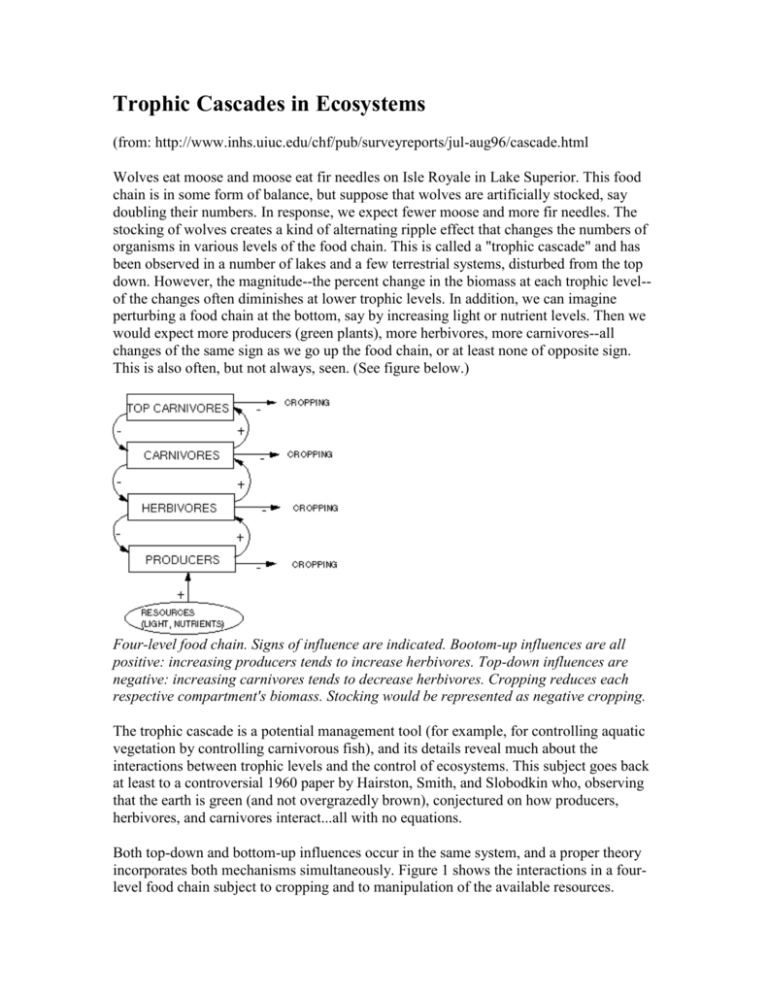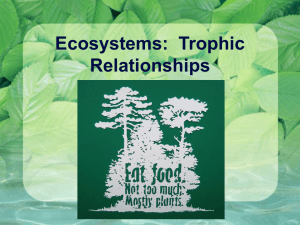Trophic Cascades in Ecosystems
advertisement

Trophic Cascades in Ecosystems (from: http://www.inhs.uiuc.edu/chf/pub/surveyreports/jul-aug96/cascade.html Wolves eat moose and moose eat fir needles on Isle Royale in Lake Superior. This food chain is in some form of balance, but suppose that wolves are artificially stocked, say doubling their numbers. In response, we expect fewer moose and more fir needles. The stocking of wolves creates a kind of alternating ripple effect that changes the numbers of organisms in various levels of the food chain. This is called a "trophic cascade" and has been observed in a number of lakes and a few terrestrial systems, disturbed from the top down. However, the magnitude--the percent change in the biomass at each trophic level-of the changes often diminishes at lower trophic levels. In addition, we can imagine perturbing a food chain at the bottom, say by increasing light or nutrient levels. Then we would expect more producers (green plants), more herbivores, more carnivores--all changes of the same sign as we go up the food chain, or at least none of opposite sign. This is also often, but not always, seen. (See figure below.) Four-level food chain. Signs of influence are indicated. Bootom-up influences are all positive: increasing producers tends to increase herbivores. Top-down influences are negative: increasing carnivores tends to decrease herbivores. Cropping reduces each respective compartment's biomass. Stocking would be represented as negative cropping. The trophic cascade is a potential management tool (for example, for controlling aquatic vegetation by controlling carnivorous fish), and its details reveal much about the interactions between trophic levels and the control of ecosystems. This subject goes back at least to a controversial 1960 paper by Hairston, Smith, and Slobodkin who, observing that the earth is green (and not overgrazedly brown), conjectured on how producers, herbivores, and carnivores interact...all with no equations. Both top-down and bottom-up influences occur in the same system, and a proper theory incorporates both mechanisms simultaneously. Figure 1 shows the interactions in a fourlevel food chain subject to cropping and to manipulation of the available resources. Early in the discussion there was a tendency to talk of top-down and bottom-up effects as mutually exclusive. After listening to colleagues and their strongly held opinions, I began to feel that the problem represented by Figure 1 had strong analogies to the physics of magnetism (a food chain was just a linear chain with nearest-neighbor interactions). While only nearest neighbors in the food chain interact directly, all compartments interact indirectly as they respond to changes in resources and to cropping. Rather than use the rusty machinery from magnetism, I sought intuitive arguments of how the trophic cascade should pop out of Figure 1. The arguments were not very convincing, and each time a Survey colleague reviewed them, he asked for more rigor. The final stroke came when a well-respected systems ecologist and modeller with a physics background said, "You may not be right." Then I dusted off the mathematics and solved the problem exactly. The resulting approach combines all interactions shown by arrows in Figure 1. The crux of how one level impacts another is the degree to which a preyed-upon level can compensate its reduced biomass by capturing more of its prey. With high compensation, top-down effects diminish rapidly at lower trophic levels, which is often seen experimentally. For the particular type of predator-prey interaction known as ratio dependence (which is part of a continuing debate), the trophic cascade should produce changes that alternate in sign and diminish by a factor of roughly ten at each successively lower level. In that case a 10% increase in the top carnivore biomass will produce changes of -1%, +0.1%, and -0.01% in carnivores, herbivores, and producers, respectively. The last of these is likely undetectable over experimental noise, and hence consistent with some observations that the trophic cascade disappears around the level of zooplankton. On the other hand, the same system shows changes of the same sign and magnitude for a bottom-up perturbation, which is sometimes observed. If instead "prey-dependent" predation (the basis of the Lotka-Volterra predator-prey equations) is assumed, the trophic cascade is not seen. Rather than a pattern of (+ - + -), we see a pattern (+ 0 + 0), which is suspected in some river systems. The approach I have developed seems to be able to predict essentially all observed patterns in experiments. Future work will include testing this claim more carefully. As usual, there will be the necessary job of testing a theory that is logically satisfying, but based on many simplifications, against real biological mechanisms and data. Complicating factors include: 1. the fact that food chains are often actually webs, in which case the theory here breaks down, 2. the difficulty of applying a theory based on steady state to real dynamic systems, 3. the complexity of real predator-prey interactions, including prey shifts at different life stages and under different environmental conditions, 4. the possiblity that the predicted effects are too small to detect experimentally. Reference: Herendeen, R. 1995. A unified quantitative approach to bottom-up:top-down and trophic cascade hypotheses. Journal of Theoretical Biology 176:13-26. Robert Herendeen, Center for Aquatic Ecology








